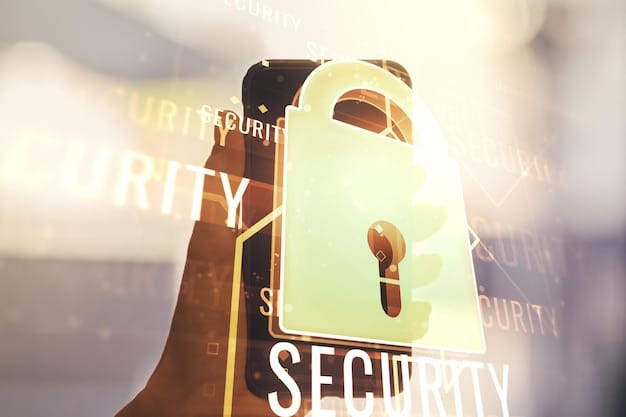Mobile Security Guide: 7 Proven Ways to Secure Your Smartphone

This mobile security guide outlines seven essential strategies to protect your smartphone from hackers, including strong passwords, software updates, app permissions, secure Wi-Fi usage, avoiding phishing scams, enabling remote wiping, and using mobile security apps.
In today’s digital age, our smartphones are mini-computers holding vast amounts of personal and professional data. Protecting them from cyber threats is crucial. This mobile security guide: 7 ways to protect your smartphone from hackers will equip you with the knowledge and actionable steps to secure your device effectively.
Understanding the Threats to Your Smartphone Security
Before diving into solutions, it’s important to understand the types of threats smartphones face. These threats can range from simple malware to sophisticated phishing attacks, each designed to compromise your data or gain unauthorized access to your device.
Common Types of Mobile Threats
Smartphones are vulnerable to various threats, including malware, phishing, and insecure Wi-Fi networks. Each poses a unique risk to your data and privacy.
The Importance of Mobile Security
Mobile security is essential because smartphones contain sensitive information like bank details, personal photos, and work emails. A breach can lead to identity theft, financial loss, or data exposure.

Understanding these threats is the first step toward securing your smartphone. Implement the following strategies to enhance your device’s security.
1. Implementing Strong Passwords and Biometric Authentication
One of the most basic yet crucial steps in securing your smartphone is using strong passwords. Combine this with biometric authentication, such as fingerprint or facial recognition, for enhanced security.
Creating Strong, Unique Passwords
A strong password should be long, complex, and unique. Avoid using personal information or common words.
Enabling Biometric Authentication
Biometric authentication adds an extra layer of security by verifying your identity through unique biological traits.
- Use a combination of letters, numbers, and symbols.
- Avoid using the same password across multiple accounts.
- Use a password manager to generate and store complex passwords securely.
By implementing strong passwords and biometric authentication, you significantly reduce the risk of unauthorized access to your smartphone.
2. Keeping Your Smartphone Software Updated
Software updates are crucial for maintaining the security of your smartphone. These updates often include security patches that address vulnerabilities discovered in the operating system and pre-installed apps.
Why Software Updates are Important
Software updates protect against newly discovered security threats.
Enabling Automatic Updates
Automatic updates ensure you always have the latest protection.

Regularly updating your smartphone’s software is a simple yet effective way to protect against potential security breaches.
3. Reviewing and Limiting App Permissions
Apps often request various permissions to access your smartphone’s features, such as camera, microphone, and location. Reviewing and limiting these permissions can help protect your privacy and security.
Understanding App Permissions
App permissions control what data an app can access. Limit unnecessary permissions to protect your data.
Limiting App Permissions on Android and iOS
Both Android and iOS allow you to manage app permissions through the settings menu.
- Regularly review the permissions granted to each app.
- Revoke permissions that seem excessive or unnecessary.
- Be cautious when granting permissions to new apps.
By carefully managing app permissions, you can reduce the risk of apps misusing your data or compromising your privacy.
4. Using Secure Wi-Fi Networks and VPNs
Public Wi-Fi networks are often unsecured, making them a potential risk to your smartphone security. Use secure Wi-Fi networks whenever possible, and consider using a Virtual Private Network (VPN) for added protection.
The Risks of Public Wi-Fi
Public Wi-Fi networks can be easily intercepted by hackers to steal sensitive information.
How VPNs Enhance Security
VPNs encrypt your internet traffic, making it difficult for hackers to intercept your data.
Using secure Wi-Fi and VPNs can significantly reduce the risk of data interception and enhance your overall mobile security.
5. Avoiding Phishing Scams and Suspicious Links
Phishing scams are a common tactic used by hackers to steal sensitive information. Be cautious of suspicious emails, messages, and links, and avoid clicking on anything that seems too good to be true.
Recognizing Phishing Attempts
Phishing attempts often involve urgent requests, grammar errors, and suspicious links.
Protecting Yourself from Phishing
Verify the sender’s identity before clicking on any links or providing personal information.
- Be wary of emails or messages asking for sensitive information.
- Verify the sender’s identity before clicking on any links.
- Never enter personal information on websites accessed through suspicious links.
By staying informed about phishing tactics and practicing caution, you can protect yourself from falling victim to these scams.
6. Enabling Remote Wiping and Location Tracking
In case your smartphone is lost or stolen, enabling remote wiping and location tracking can help you protect your data. Remote wiping allows you to erase all data on your device, while location tracking can help you locate it.
Setting Up Remote Wiping
Remote wiping allows you to erase your data if your device is lost or stolen.
Enabling Location Tracking
Location tracking can help you locate your device if it’s lost or stolen.
Enabling these features can provide peace of mind and protect your data in the event of loss or theft.
7. Using Mobile Security Apps and Antivirus Software
Mobile security apps and antivirus software can provide an extra layer of protection against malware and other threats. These apps can scan your device for malware, block malicious websites, and provide other security features.
Benefits of Mobile Security Apps
Mobile security apps offer real-time protection against malware and other threats.
Choosing the Right Security App
Select a reputable security app with strong reviews and a proven track record.
Using mobile security apps and antivirus software can enhance your smartphone’s security and protect against a wide range of threats.
| Key Point | Brief Description |
|---|---|
| 🔑 Strong Passwords | Use complex, unique passwords and biometric authentication. |
| 🛡️ Software Updates | Keep your device updated to patch security vulnerabilities. |
| 📶 Secure Wi-Fi | Use VPNs on public networks to encrypt your data. |
| 🔍 App Permissions | Review and limit app permissions to protect your privacy. |
Frequently Asked Questions
▼
One of the biggest threats is unsecured public Wi-Fi because hackers can easily intercept your data. Always use a VPN or stick to secure, private networks.
▼
You should update your smartphone’s software as soon as updates are available. These updates often include critical security patches to protect your device.
▼
If you suspect a phishing attempt, do not click any links or provide personal information. Report the suspicious email or message to the appropriate authorities.
▼
Not all free mobile security apps are reliable. It’s important to choose reputable apps with strong reviews and a proven track record to ensure effective protection.
▼
Enable remote wiping and location tracking on your smartphone. This allows you to erase your data and possibly locate your device if it’s lost or stolen.
Conclusion
Protecting your smartphone from hackers is crucial in today’s digital landscape. By implementing strong passwords, keeping your software updated, managing app permissions, using secure Wi-Fi, avoiding phishing scams, enabling remote wiping, and using mobile security apps, you can significantly enhance your device’s security and protect your personal and professional data.





